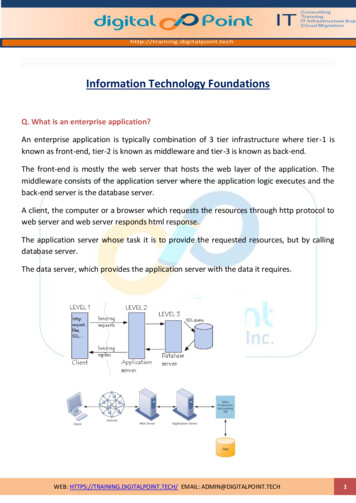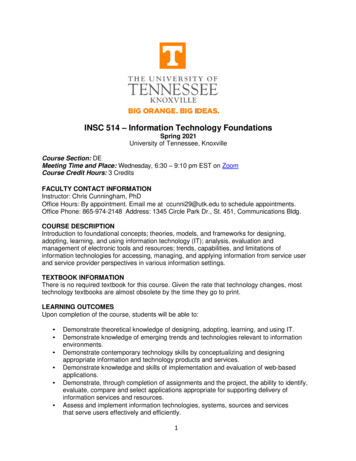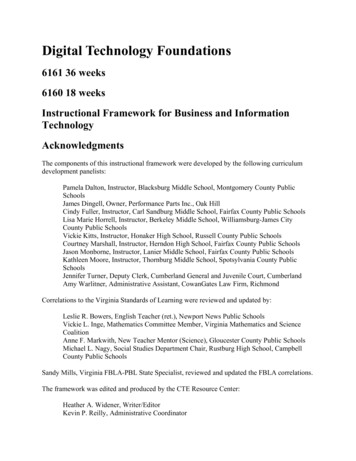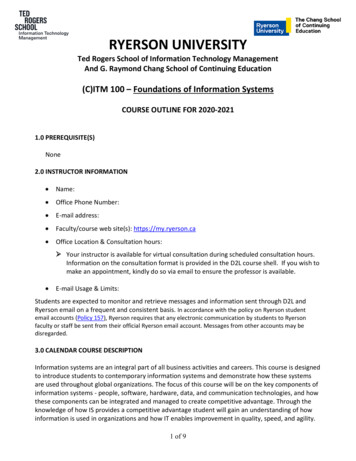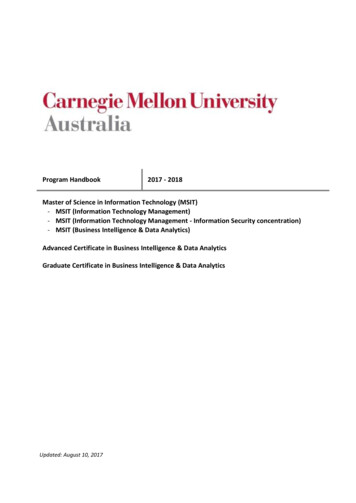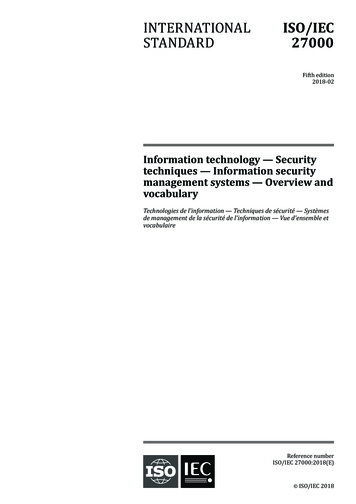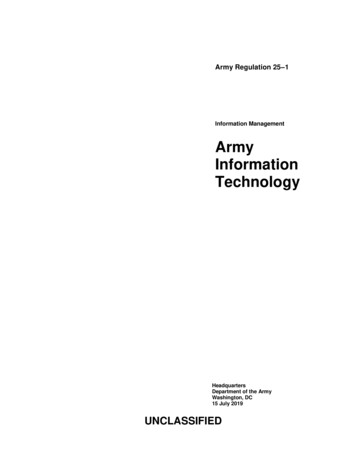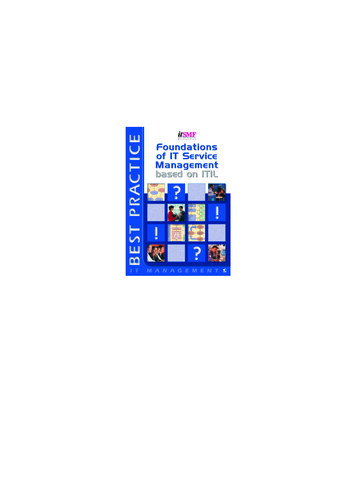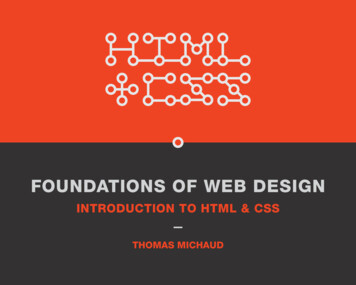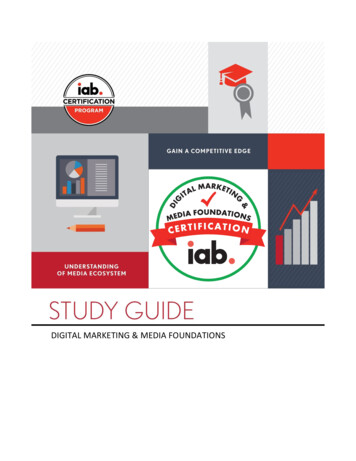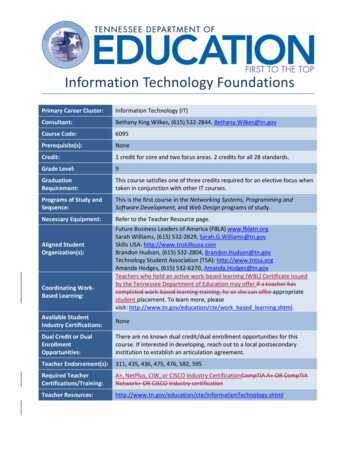
Transcription
Information Technology FoundationsPrimary Career Cluster:Information Technology (IT)Consultant:Bethany King Wilkes, (615) 532-2844, Bethany.Wilkes@tn.govCourse Code:6095Prerequisite(s):NoneCredit:1 credit for core and two focus areas. 2 credits for all 28 standards.Grade Level:9GraduationRequirement:This course satisfies one of three credits required for an elective focus whentaken in conjunction with other IT courses.Programs of Study andSequence:This is the first course in the Networking Systems, Programming andSoftware Development, and Web Design programs of study.Necessary Equipment:Refer to the Teacher Resource page.Aligned StudentOrganization(s):Coordinating WorkBased Learning:Future Business Leaders of America (FBLA) www.fblatn.orgSarah Williams, (615) 532-2829, Sarah.G.Williams@tn.govSkills USA: http://www.tnskillsusa.comBrandon Hudson, (615) 532-2804, Brandon.Hudson@tn.govTechnology Student Association (TSA): http://www.tntsa.orgAmanda Hodges, (615) 532-6270, Amanda.Hodges@tn.govTeachers who hold an active work-based learning (WBL) Certificate issuedby the Tennessee Department of Education may offer If a teacher hascompleted work-based learning training, he or she can offer appropriatestudent placement. To learn more, pleasevisit: http://www.tn.gov/education/cte/work based learning.shtml.Available StudentIndustry Certifications:NoneDual Credit or DualEnrollmentOpportunities:There are no known dual credit/dual enrollment opportunities for thiscourse. If interested in developing, reach out to a local postsecondaryinstitution to establish an articulation agreement.Teacher Endorsement(s):311, 435, 436, 475, 476, 582, 595Required TeacherCertifications/Training:A , NetPlus, CIW, or CISCO Industry CertificationCompTIA A OR CompTIANetwork OR CISCO Industry certificationTeacher ionTechnology.shtml
Course DescriptionInformation Technology Foundations (ITF) is a course intended to provide students with exposure tovarious information technology occupations and pathways such as Networking Systems, Programmingand Software Development, and Web Design. As a result, students will complete all core standards, aswell as standards in two of three focus areas. Proficient students will be able to describe variousinformation technology (IT) occupations and professional organizations. Moreover, they will be able todemonstrate logical thought processes and discuss the social, legal, and ethical issues encountered inthe IT profession. Depending on the focus area, proficient students will also demonstrate anunderstanding of electronics and basic digital theory; project management and teamwork; clientrelations; causes and prevention of Internet security breaches; and writing styles appropriate for webpublication. Upon completion of the ITF course, students will be prepared to make an informed decisionabout which Information Technology program of study to pursue. Standards in this course are alignedwith Tennessee State Standards for English Language Arts & Literacy in Technical Subjects andTennessee State Standards in Mathematics.*The following implementation options are encouraged: 1 credit for core and two focus areas (listed below) 2 credits for all 28 standardsCore standards are required for both one and two credit implementation options.Core standards: 1, 2, 7, 8, 22Focus AreasNetworking Systems:Programming & Software Development:Web Design:Standards3, 4, 5, 6, 10, 12, 15, 2416, 26, 27, 289, 11, 13, 14, 17, 18, 19, 20, 21, 23 25Program of Study ApplicationThis is the first course in the Networking Systems, Programming and Software Development, and WebDesign programs of study. For more information on the benefits and requirements of implementingthese programs in full, please visit the Information Technology websiteat ogy.shtml.Course StandardsSafety1) Accurately read, and interpret, and demonstrate adherence to safety rules, including (1) rulespublished by the National Science Teachers Association (NSTA), (2) rules pertaining to electricalsafety, (3) Internet safety, (4) Occupational Safety and Health Administration (OSHA) guidelines,and (5) state and national code requirements. Be able to distinguish between rules and explainwhy certain rules apply. (TN Reading 3, 4, 6)2) Identify and explain the intended use of safety equipment available in the classroom. Forexample, demonstrate how to properly inspect, use, and maintain safe operating procedureswith tools and equipment. (TN Reading 3, 4)Page 2
Electronics and Basic Digital Theory3) Demonstrate understanding of electrical circuits and devices, and relate to the physical laws(such as Ohm’s Law and power laws) that govern behaviors of electrical circuits and devices.Accurately apply these physical laws to solve problems. For example, calculate the resistance ofa DC circuit with a given DC voltage and current. (TN Reading 3, 4; TN Math N-Q, A-CED, A-REI, FBF)4) Assemble the required connections of electronic test equipment to properly test the operationof basic electronic circuit behavior and performance, using equipment such as a digitalmultimeter. For example, demonstrate the proper use of a digital multimeter by measuringresistance of a circuit in a typical computer system; compare this finding by calculating theresistance given the voltage and current. (TN Reading 3; TN Math N-Q)5) Distinguish between the binary and hexadecimal counting systems. Using appropriate units,provide examples of each system and identify specific instances when IT professionals rely onthem. (TN Reading 4; TN Math N-Q, A-CED)6) Explain the functions of gates in logic circuits (e.g., AND, OR, NOT). For example, construct atruth table for the seatbelt warning light in an automobile. (TN Reading 3, 7; TN Writing 4, 7)Career Exploration7) Research various occupations in information technology industries, such as programmers, webdesigners, webmasters, networking administrators, computer systems administrators, andtelecommunications line installers. Compose an informative table or chart that includes thefollowing: work activities typically performed, tools and technology used, nature of workenvironment, and the knowledge and skills needed for success. (TN Reading 7; TN Writing 2, 4,7)8) Explore various professional societies related to information technology and identify theservices and benefits provided by each member. Create a table that lists their purposes, benefitsto membership, and any certifications affiliated with the organization. For example, investigatethe Institute for Electrical and Electronics Engineers (IEEE), Computing Technology IndustryAssociation (CompTIA), and the Association for Computing Machinery (ACM). (TN Reading 1, 7;TN Writing 2, 4)Overview of the Internet9) Drawing on multiple sources (i.e., internet, textbooks, videos, and journals), research the historyof the Internet. Create a timeline or infographic, illustrating the Internet’s historical evolutionfrom its inception to the present time. Discuss the needs that led to the creation of the Internet;discuss both the benefits and disadvantages of the Internet to society, as well as potentialimplications for the future. Provide examples drawn from the research to support claims. (TNReading 1, 7; TN Writing 2, 8)Page 3
Overview of Operating Systems10) Drawing on multiple sources (i.e., internet, textbooks, videos, and journals), research the historyand development of operating systems (e.g., Microsoft Windows, Linux, UNIX). Create apresentation, illustrating their historical evolution, from their inceptions to the present, citinginformation found in research. Compare and contrast the general capabilities of a variety ofoperating systems, and explain how their designs and functionalities have improved over time.(TN Reading 1, 7; TN Writing 2, 7, 8, 9)Terminology and Concepts11) Demonstrate an understanding of basic web terminology and concepts. Practice explainingthese terminologies and concepts by creating methods to help students learn and rememberthe information. For example, students should be able to explain the purpose of terminologysuch as server, domain name system (DNS) , internet service provider (ISP), hardware andsoftware connective devices, cloud computing, remote access protocols, map protocols, contentmanagement systems (CMS), cascading style sheets (CSS), and social networking terms. (TNReading 1, 4)12) Demonstrate a basic understanding of computer hardware components. Identify thesecomponents using pictures or actual models and briefly explain the function of each.Components should include, but are not limited to:a. Hardware used for input and outputb. Hardware inside the computer casec. Motherboardd. Processor and the chipsete. Storage devices (e.g., primary, secondary)f. Expansion cardsg. Electrical system(TN Reading 1, 4, 7)Keyboard Shortcuts13) Identify, explain, and demonstrate the use of common keyboard shortcuts. Create a quickreference guide that would be user-friendly for a novice web designer. For example, studentsmay create a multiple column table showing keyboard shortcuts for navigation, text editing, andtext formatting. The table would identify which shortcuts are applicable to using Windowsversus Mac OS. (TN Reading 1, 7, 9; TN Writing 4)Introduction to Logical Thought Process14) There are different versions of the web design and development process. For example, mostversions of the web design and development process involve project definition, site structure,visual design, site development, testing, refining, and launch. Using various resources, research,identify, and explain the steps involved in the process. As a class, develop an agreed-uponframework for applying the logical thought process to web design projects in the form of aPage 4
flowchart or logic model, justifying the reasoning behind each step. Explain why it is an iterativeprocess and always involves refinement. (TN Reading 7; TN Writing 1, 4)15) Research, identify, and describe the specific activities involved at each step of thetroubleshooting process, including by not limited to:Troubleshooting a computer problem is asystematic process that can be performed in various ways. For example, the following stepsrepresent a general problem solving approach: 1) gather information from the user or operatorand back up data, 2) verify the problem exists, 3) isolate the cause of the problem and generatealternative solutions, 4) plan a solution and resolve the problem, 5) verify that the problem wasresolved and prevent a future occurrence, and 6) document findings, resolution, andpreventative maintenance plan. Using various resources, research, identify, and explain thesteps involved in the above process. Create a presentation that details the specific activitiesinvolved at each step. Explain why it is important to document the process throughout. (TNReading 7; TN Writing 12, 4, 7)16) Demonstrate an understanding of flowcharts and know what various symbols mean. Identify aproblem that a programmer would solve using the logical thinking process, and create aflowchart that would guide the code development. For example, create a flowchart thatincorporates at least three decisions, or paths, to solve a problem. (TN Reading 3, 4, 7; TNWriting 2, 4)Teamwork & Project Management17) Explore how teams are formed to complete and manage web design and development projects.Using the information gained from research, identify and explain various roles andresponsibilities for members of a web design and development team. Include why teams aremore efficient than individuals in the web design and development process. Present the findingsto classmates. (TN Reading 7; TN Writing 2, 4, 7, 9)18) Synthesize common principles and templates for successful project management. Explain, usingexamples, why strong management skills are important in the web design and developmentprocess. (TN Reading 1, 2, 4; TN Writing 1)Client Relations19) Research and identify the skills that are required to communicate effectively with a client.Develop a questionnaire that would be used to determine the needs of a client for a prospectiveweb development project. Using the questionnaire, conduct mock client interviews withclassmates and provide each other with constructive feedback to revise the questionnaire andprocess. (TN Reading 1; TN Writing 4, 5, 7)Writing and Editing for Web Publication20) As a team, list primary rules to guide writing content that is appropriate for a web sitepublication. Apply these rules to a variety of web-based writing assignments throughout thecourse. For example, develop and maintain a blog throughout the course to practice appropriatewriting techniques and style for web publication. (TN Reading 1, 3; TN Writing 4, 5)Page 5
21) Given a specific client’s vision, create a simple web site using a content management system(CMS) such as WordPress. Follow the multistep process to download the software application ofchoice, and demonstrate how to upload and store files. Practice proofreading and critiquingother classmates’ sites, and provide constructive feedback on one another’s writing and layoutdesign. (TN Reading 3; TN Writing 4, 5, 6)Social, Legal, and Ethical Issues22) Drawing on multiple sources (i.e., internet, textbooks, videos, and journals), research the varioussocial, legal, and ethical issues encountered by IT professionals. Using these findings, identifythe roles and responsibilities one must consider while developing a prospective project oraddressing an IT problem. For example, web developers and programmers must apply copyrightlaws and understand uses of open source software. (TN Reading 1, 4)Security23) Demonstrate an understanding of the various security breaches that can occur with theInternet. Prepare a text explaining enterprise-level security, the purpose of encryption, and theprotocols that can be implemented to secure web sites. Evaluate personal privacy issues versusemployers’ rights to regulate computing resources. (TN Reading 2, 4, 5; TN Writing 2, 4)24) Identify various security practices for computer and network systems, such as how to controlaccess to secured resources and computer resources. Give specific examples of methods that anadministrator can use, like encryption techniques, basic input/output system (BIOS) features,and strategies for dealing with malware. (TN Reading 1, 4)Organization of Materials25) Understand and demonstrate the effective use of file and folder management techniques tomaintain directory structure for a web site. Describe the most efficient methods for digital filemanagement, including the use of site root and subfolders for assets (e.g., images, templates,CSS). (TN Reading 3, 4)Programming26) Explore and identify various languages, such as Python, HTML, PHP, C , Visual Basic, Java,JavaScript, and C#. Explain how programmers use these languages to solve a variety of ITproblems, furnishing examples of how they are applied. (TN Reading 1, 4, 7)27) Using various resources, research, identify, and explain the steps involved in the There aredifferent versions of the software development life cycle. For example, in most versions the,including but not limited to: process involves planning, designing, coding, testing, deployment,and maintenance. Using various resources, research, identify, and explain the steps involved inthe process. Create a presentation that details the specific activities involved at each step of theprocess. Explain why it is an iterative process and always involves refinement. (TN Reading 2, 6,7; TN Writing 1, 4, 7)Page 6
28) Demonstrate an understanding of how batch files function within a programming environment.Identify common commands to create code for batch files (e.g., title, echo, echo off, pause, CLS,ipconfig, and ping). For example, list various scenarios for using batch files to complete specificprogramming tasks. Create and execute batch file code to perform one of the tasks identified.(TN Reading 3, 4, 8)Standards Alignment Notes*References to other standards include: TN Reading: Tennessee State Standards for English Language Arts & Literacy in History/SocialStudies, Science, and Technical Subjects; Reading Standards for Literacy in Science and TechnicalSubjects 6-12; Grades 9-10 Students (page 62).o Note: While not directly aligned to one specific standard, students who are engaging inactivities outlined above should be able to also demonstrate fluency in Standard 10 atthe conclusion of the course. TN Writing: Tennessee State Standards for English Language Arts & Literacy in History/SocialStudies, Science, and Technical Subjects; Standards for Literacy in History/Social Studies,Science, and Technical Subjects 6-12; Grades 9-10 Students (pages 64-66).o Note: While not directly aligned to one specific standard, students who are engaging inactivities outlined above should be able to also demonstrate fluency in Standards 3 and10 at the conclusion of the course.http://www.corestandards.org/assets/CCSSI ELA%20Standards.pdf TN Math: Tennessee State Standards for Mathematics; Math Standards for High School: Numberand Quantity, Algebra, Functions (pages 58-83).o Note: The standards in this course are not meant to teach mathematical concepts.However, the concepts referenced above may provide teachers with opportunities tocollaborate with mathematics educators to design project-based activities or collaborateon lesson planning. Students who are engaging in activities listed above should be ableto demonstrate quantitative, algebraic, and functional reasoning as applied to specifictechnical concepts. In addition, students will have the opportunity to practice the habitsof mind as described in the eight Standards for Mathematical Practice. P21: Partnership for 21st Century Skills Framework for 21st Century Learningo Note: While not all standards are specifically aligned, teachers will find the frameworkhelpful for setting expectations for student behavior in their classroom and practicingspecific career readiness skills.Page 7
Programming & SoftwareDevelopment PracticumPrimary Career Cluster:Information Technology (IT)Consultant:Bethany King Wilkes, (615) 532-2844, Bethany.Wilkes@tn.govCourse Code(s):TBDPrerequisite(s):Algebra I (3012), Information Technology Foundations (6095),Programming & Logic I (6098), and Programming & Logic II (6099)Credit:1Grade Level:11-12Graduation Requirements:This course satisfies one of three credits required for an elective focuswhen taken in conjunction with other Information Technology courses.Programs of Study andSequence:This is the capstone course in the Programming & SoftwareDevelopment program of study.Necessary Equipment:Computer laboratoryAligned StudentOrganization(s):Coordinating Work-BasedLearning:Available Student IndustryCertifications:Dual Credit or DualEnrollment Opportunities:Teacher Endorsement(s):Required TeacherCertifications/Training:Skills USA: whttp://www.tnskillsusa.comBrandon Hudson, (615) 532-2804, Brandon.Hudson@tn.govTechnology Student Association (TSA): http://www.tntsa.orgAmanda Hodges, (615) 532-6270, Amanda.Hodges@tn.govTeachers who hold an active work-based learning (WBL) Certificateissued by the Tennessee Department of Education may offerinternships, cooperative education, service learning, and jobshadowing through this course.If a teacher has completed work-basedlearning training, appropriate student placement can be offered. Tolearn more, visithttp://tn.gov/education/cte/work based learning.shtml.TBDThere are no known dual credit/dual enrollment opportunities for thiscourse. If interested in developing, reach out to a local postsecondaryinstitution to establish an articulation agreement.037, 041, 055, 056, 057, 203, 204, 311, 434, 435, 436, 474, 475, 476,595, 742If students are assigned in work-based learning settings, teachers mustattend WBL training and earn the WBL Certificate provided by
Information Technology Foundations (ITF) is a course intended to provide students with exposure to various informati
